Settler Canadians still have a lot to learn about residential schools, and turning to the truth and wisdom of Survivors is a good place to start.
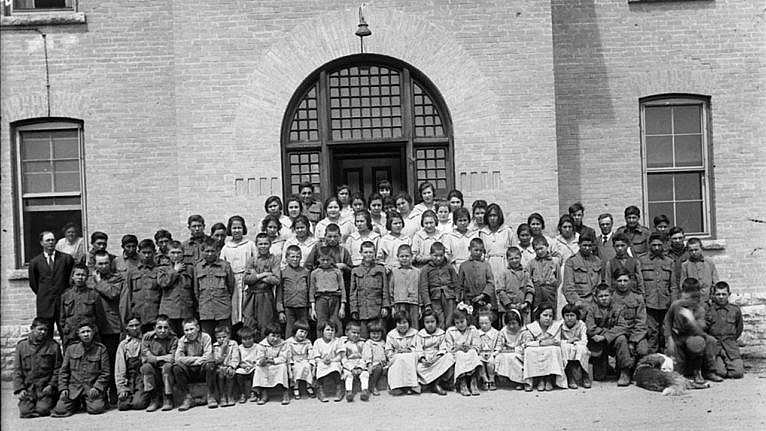
Photo: Group of students posing in front of the Brandon Indian Residential School, Brandon, Manitoba, 1946. Source: Library and Archives Canada/National Film Board of Canada fonds/a048574
Talking to kids about residential schools can be tough. These traumatizing and culture-stripping institutions imposed death, abuse and other types of inhumane cruelty onto innocent children. But just because it’s hard doesn’t mean we should shy away from it. This is especially true in light of the recent and horrific discovery of the remains of 215 children found on the grounds of the former Kamloops Indian Residential School in B.C.
“These were 215 beautiful, trusting little spirits who believed in their hearts that it would all work out,” said Senator Mary Jane McCallum in a recent statement to the senate. McCallum was taken from her Cree family to a residential school in Manitoba when she was just five years old. “They missed their families and never understood how they came to be where they were. One of my most persistent emotions in residential school was overwhelming loneliness and a bewildering feeling of abandonment.”
“This is Canada,” McCallum continued. “Our hearts are broken. Canada is broken.”
For non-Indigenous parents who are settlers of this country, we cannot reverse the irreparable pain and intergenerational trauma residential schools inflicted on Indigenous families across Canada. But we can seek to understand and educate—both ourselves and our children. Once we start filling in the gaps in our own knowledge and understanding our own role in this, we can advocate, too. We can write letters to push parliament to enact the Truth and Reconciliation Commission of Canada’s (TRC) 94 calls to action in their totality, and we can be mindful of Indigenous causes when we exercise our right to vote.
Canadians still have a lot to learn, and these quotes from residential school Survivors (from the 2015 TRC Survivors Speak report) and accompanying images can help us begin to understand and start the conversations with our children.
No chance to say goodbye
Frederick Ernest Koe, who attended residential school in the Northwest Territories, remembers hearing a knock at the door of his family home one day. He left shortly after with no chance to say any proper goodbyes to his family.
“Well pack up, a few little things, no suitcases, my hunting bag is still kind of dirty, throw whatever stuff you had in it and off you go. And I didn’t get to say goodbye to my dad or my brother Allan, didn’t get to pet my dogs or nothing, you know, we’re going.”
Losing precious braids
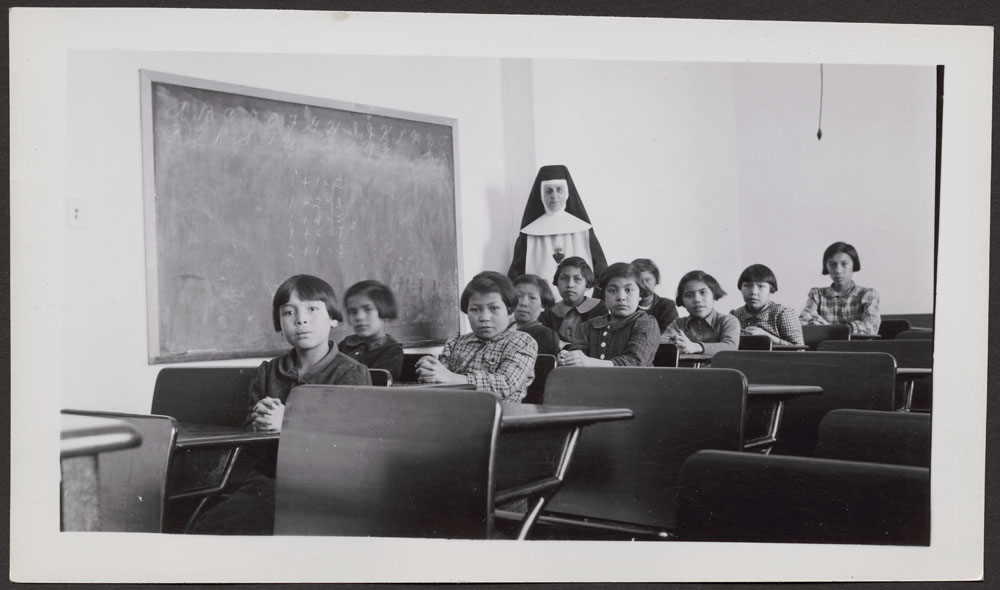
Photo: Group of female students [7th from left Josephine Gillis (nee Hamilton), 8th from left Eleanor Halcrow (nee Ross)]and a nun (Sister Antoine) in a classroom at Cross Lake Indian Residential School, Cross Lake, Manitoba, February 1940. Source: Library and Archives Canada/Department of Indian Affairs and Northern Development fonds/e011080274
Victoria Boucher-Grant, who attended a residential school in Fort William, Ont., remembers feeling shocked when they cut her long braids, which she had been growing for years.
“And they, they took my braids, and they chopped my, they didn’t even cut it, they just, I mean style it or anything, they just took the braid like that, and just cut it straight across. And I remember just crying and crying because it was almost like being violated, you know, like when you’re, when I think about it now it was a violation, like, your, your braids got cut, and it, I don’t know how many years that you spent growing this long hair.”
Boys’ hair was cut, too. Campbell Papequash attended the Roman Catholic residential school in Kamsack, Sask. and recalls the devastating experience.
“And then they cut off my beautiful hair. You know and my hair, my hair represents such a spiritual significance of my life and my spirit. And they did not know, you know, what they were doing to me. You know and I cried and I see them throw my hair into a garbage can, my long, beautiful braids.”
Wearing unfamiliar clothes 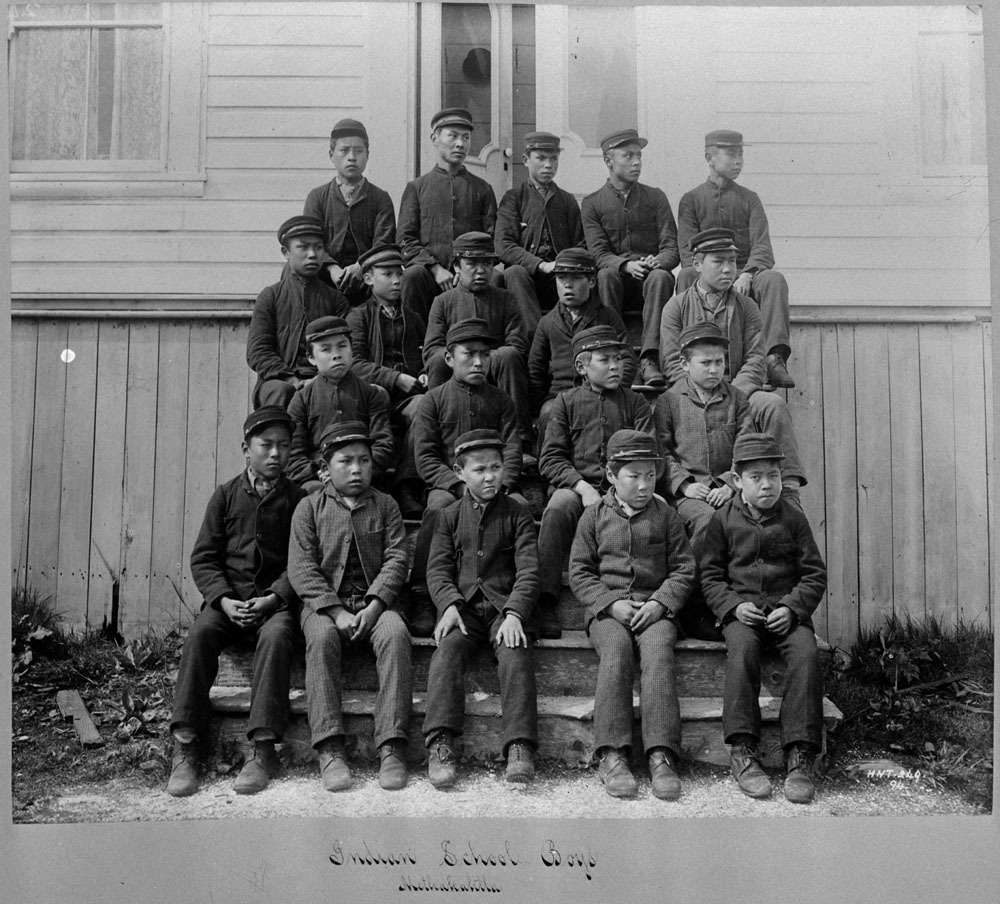
Photo: Students attending the Metlakatla Indian Residential School, British Columbia. Source: Library and Archives Canada/Ernest Alexander Cruikshank fonds/c015037
At the Metlakatla Indian Residential School in B.C. (pictured above), male students were made to wear button-front uniforms with hats and lace-up boots. These outfits were starkly different from the traditional homemade clothing Indigenous children were used to wearing, which sometimes included moccasins, buckskin jackets with beaded fringe and other clothing items made of caribou and sealskin.
Campbell Papequash remembers being given ill-fitting clothes to change into upon his arrival at the Roman Catholic residential school in Kamsack, Sask.
“And then after I had the shower they gave me these clothes that didn’t fit, and they gave me these shoes that didn’t fit and they all had numbers on them.”
Ilene Nepoose, who attended Blue Quills residential school in Alberta, remembers her clothes being taken away from her.
“I saw them on this other girl and I told the nuns that she was wearing my dress and they didn’t believe me. So, that girl ended up keeping my dress and I don’t remember what I wore, it was probably a school dress. But, that really bothered me because it was my own, like my mom made that dress for me and I was very proud of it and I couldn’t—I wasn’t allowed to wear that again.”
Numbers instead of names
Typically as soon as Indigenous children arrived at residential schools their names were replaced and they were assigned numbers.
Wilbur Abrahams attended a residential school in Alert Bay, B.C., and remembers how important it was for students to remember their numbers, as this is usually how staff referred to children.
“They told us to remember our number, instead of calling my name, they’d call my number, and if you don’t remember your number, you, you know you get yelled at. And I, I think we did extra chores, so you had to really keep memorizing your number. Mine was 989.”
Lydia Ross, who attended Manitoba’s Cross Lake Indian Residential School, recalls the different numbers she was assigned throughout her residential school experience.
“My name was Lydia, but in the school I was, I didn’t have a name, I had numbers. I had number 51, number 44, number 32, number 16, number 11, and then finally number one when I was just about coming to high school. So, I wasn’t, I didn’t have a name, I had numbers. You were called 32, that’s me, and all our clothes were, had 32 on them. All our clothes and footwear, they all had number 32, number 16, whatever number they gave me.”
Separated from siblings 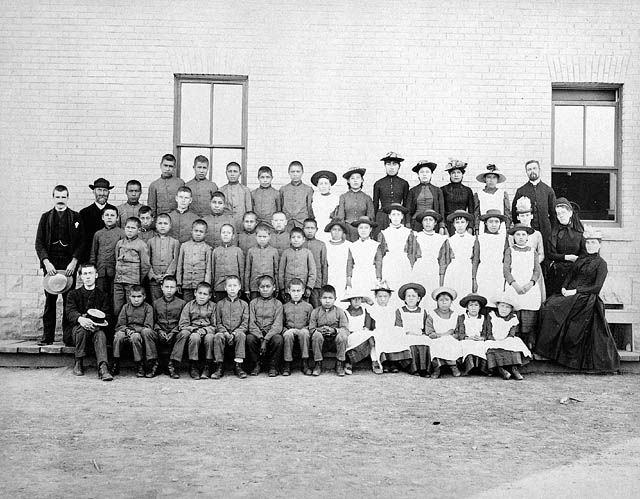
Photo: Students and staff at St. Paul’s Indian Industrial School, Middlechurch, Manitoba, ca. 1901. Source: Library and Archives Canada/David Ewens collection/e006610116
Peter Ross, who attended the Immaculate Conception residential school in Aklavik, Northwest Territories, reflects on what it felt like not being able to communicate with his sisters for the first time.
“In all that time I was there I never had a chance to talk to my sisters. You know, we’re segregated even in church. The girls had one side, the boys one side. You went to school, same thing. You never had a chance to, only at Christmas and Easter feasts I think is the only time that, we sat in the same dining room to eat together. And that’s the only time, you know, my sisters and I had a chance to talk together.”
Daniel Nanooch remembers a similar experience at the residential school he attended in Wabasca, Alta.
“They had a fence in the playground. Nobody was allowed near the fence. The boys played on this side, the girls played on the other side. Nobody was allowed to go to that fence there and talk to the girls through the fence or whatever, you can’t.”
Forced to speak a new language 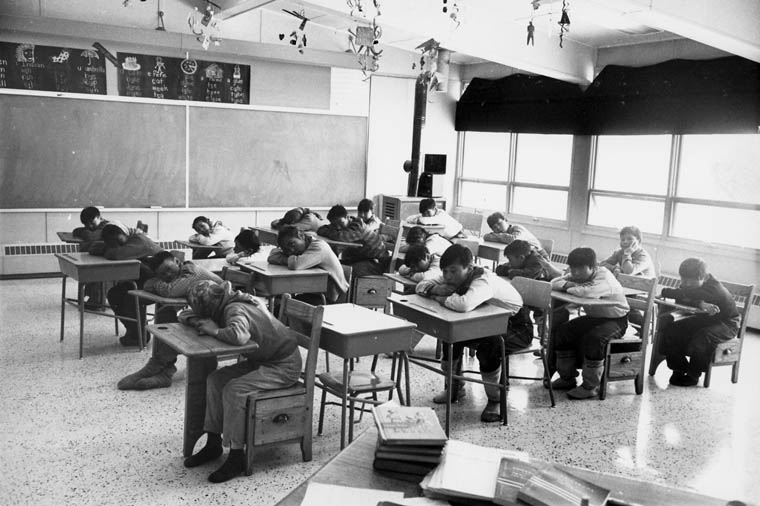
Photo: Students seated at in a classroom resting their heads on their desks, Cape Dorset (Kinngait) Federal Hostel, Nunavut, April 1964 © Library and Archives Canada. Reproduced with the permission of Library and Archives Canada Source: Library and Archives Canada/Charles Gimpel fonds/e002394546. Credit: Charles Gimpel
Indigenous children were often punished for speaking their own language at residential schools, even if they did not know English (or French at the Quebec schools).
The photo above shows a group of students at the Cape Dorset (Kinngait) Residential School in Nunavut resting their heads on their desks, which is something Arthur Ron McKay—who attended a residential school in Sandy Bay, Man.—remembers doing as a result of the repressive language rules.
“I didn’t know where to go, not even to the washroom sometimes. I just wet myself because I didn’t know where to go and I couldn’t speak to the teacher, and I know that the nuns was the teacher and I couldn’t speak English. They told me not to speak my language and everything, so I always pretended to be asleep at my desk so they wouldn’t ask me anything.”
Calvin Myerion recalled a similar experience at a residential school in Brandon, Man.
“And the time went on, and I was told not to speak my Native language, and I didn’t know any other language other than my Native language. I didn’t know a word of English, and my brother, who had been there before me, taught me in, said in my language not to talk the language. But the only way that I could communicate was through my language.”
Personal belongings taken away
Elizabeth Tapiatic Chiskamish went to residential schools in both Quebec and Ontario and remembers her personal items being taken away from her upon arrival, including clothes and food.
“The clothes we wore were taken away from us too. That was the last time we saw our clothes. I never saw the candy that my parents packed into my suitcase again. I don’t know what they did with it. It was probably thrown away or given to someone else or simply kept. When I was given back the luggage, none of things that my parents packed were still in there.”
Phyllis Webstad, who attended the St. Joseph’s Residential School in Williams Lake in B.C., remembers an orange shirt given to her by her mother being taken away too.
“I remember it was an orange shiny colour. But when I got to the Mission it was taken and I never wore it again. I didn’t understand why. Nothing was ever explained why things were happening.”
Webstad’s experience led to the creation of both Orange Shirt Day, which occurs annually on September 30, and the Orange Shirt Society, which supports residential school awareness and reconciliation.
Entering another world 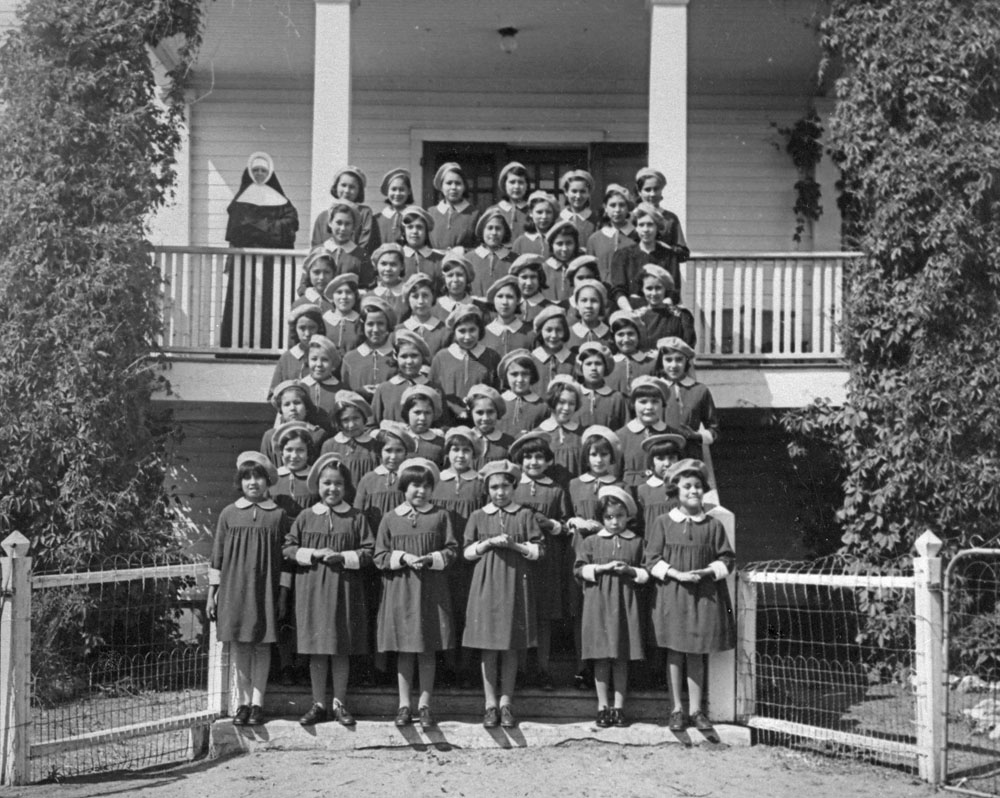
Photo: Class portrait of the female students at St. Anthony’s Indian Residential School, Onion Lake, Saskatchewan, ca. 1950© Government of Canada. Reproduced with the permission of Library and Archives Canada (2021). Source: Library and Archives Canada/Department of Indian Affairs and Northern Development fonds/e011306857
As a young girl at the Sept-Îles residential school in Quebec, Jeanette Basile Laloche wrote a poem about her residential school experience being like entering a different world.
“I was a little flower that was uprooted and transplanted into another world,” she wrote. Reflecting on the poem and her experience many years later she added, “My values were disrespected, my beliefs humiliated, I suffered infanticide. After all those horrors, my body, my mind had to adhere.”
Resources to learn more about residential schools and Indigenous culture:
The Survivors Speak
Canada’s Residential Schools: Reconciliation
TRC Final Reports
National Inquiry into Missing and Murdered Indigenous Women and Girls
Indigenous Podcasts
How to Support Survivors of Residential Schools
11 Books to Teach Kids About Residential Schools
39 Great Indigenous Stories to Read and Share with your Kids
FILED UNDER: Education Indigenous Kids residential schools School service viral truth and reconciliation
Source link : https://www.todaysparent.com/family/parenting/these-quotes-from-residential-school-survivors-can-help-kids-and-parents-understand-their-experiences












